Deus Ex: Human Revolution preview
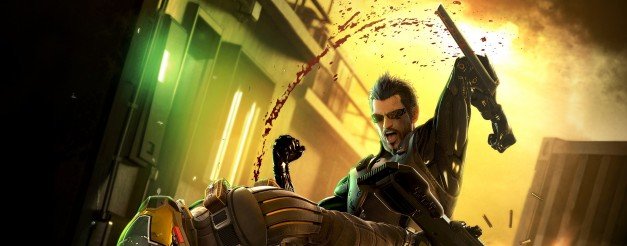
In case there was any way I could be more excited about finally playing Deus Ex: Human Revolution, the difficulty selection screen goes out of its way to make me grin:
- Casual
- Normal
- Deus Ex
Deus Ex it is. Deus Ex was an action RPG that looked like a shooter. Its genius was giving you a large number of tools to manipulate your environment, then making the most obvious one – using guns to shoot people – prohibitively difficult. It didn't just let you get creative, it forced you to be.
In Human Revolution, much is different to the original Deus Ex, much is more accessible, and much is more cinematic. But playing it, I discovered it's still a game that slaps you in the face for treating it like Halo. The PC version wasn't ready to try, but I played the first three hours of the game on the Xbox 360, which is the same experience except for my extraordinary clumsiness with a controller.
The very first interactive scene of the game captures both the cleverness and the absurdity of the original. You're head of security at Sarif Industries, protecting the scientist who's about to reveal a major breakthrough to the US government. Her name's Megan, and she happens to be your ex girlfriend.
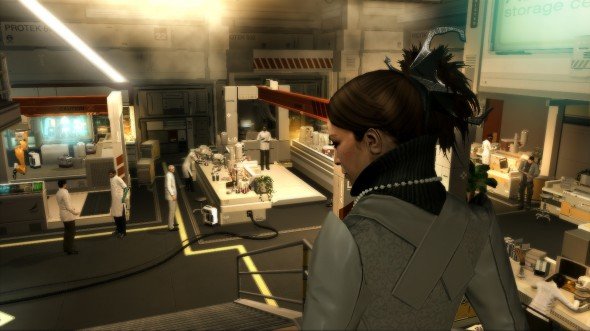
But there's a whole second layer to that plot to be discovered by snooping around Megan's office: reading her private data pads, logging onto her computer and going through emails about everything from corporate secrets to who's going to look after her dog while she's away. All while she stands by the door waiting to present the most important scientific discovery of a generation to Washington.
Minutes later assassins are storming the building slaughtering all of Sarif's scientists, and you're sent to stop them. While you do play this section, it's best seen as backstory: you're not augmented, and the assault rifle in your hands is pretty much your only combat option. The rest of the game takes place six months later, and from what I've seen it doesn't force you to use one approach like this again.
Whether you play stealthily, aggressively or both, combat in Human Revolution is all about cover. You press a key to stick to it, the game switches to third person to show what you're hidden from, then you release that key to come back out. The switch of perspective isn't jarring in itself: when you know what wall you're gluing yourself to, it feels natural and useful to be able to see exactly where you are and beyond.
The biggest gaming news, reviews and hardware deals
Keep up to date with the most important stories and the best deals, as picked by the PC Gamer team.
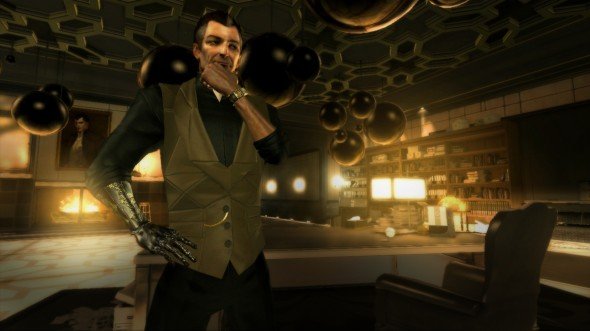
But the intricate sections I played were full of little corners, and on several occasions I stuck to a bit of cover I didn't plan to. When your perspective changes to show you in a place you didn't think you were going to, that is confusing. Whether it'll still be a problem when playing with a mouse I don't know.
On Deus Ex difficulty, you die almost instantly under fire. If a bullet only scrapes you, it takes around 30 seconds to recover from the hit. Even on Normal, health doesn't regenerate for a significant time after you're shot. It feels much more serious than a Call of Duty gunshot wound, despite the fact that no one throws jam in your eyes to obscure your vision.
Almost everywhere you fight is a multi-layered space: there's always some vertical variation, whether it's stairs or a sheer drop. The open areas are littered with things to hide behind: tables, cabinets, and our eternal friend the crate. And your enemies roam that space with admirable moxy.
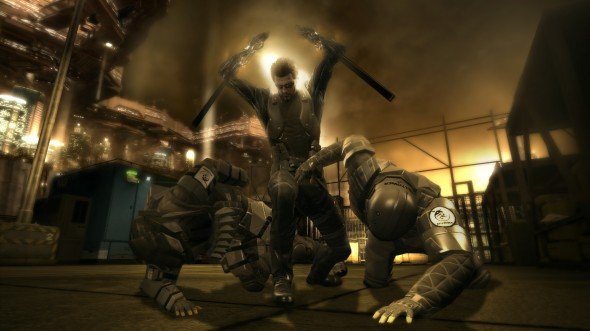
There don't seem to be set patrol routes to learn, the AI guards explore of their own accord and often vary their behaviour – particularly once they're alerted. Every time I died and restarted a section, the guards moved through the space in a different pattern.
Right now, though, guards sometimes behave stupidly under pressure. One failed to kill me as I blundered past him and through the door he was facing, closing it behind me to delay him. As soon as it shut, he blurted “Where did he go?” The cupboard, dude, you just watched me shut myself in the cupboard.
It's too soon to call, but I wouldn't be surprised if some of these behavioural anomalies were still around in the finished game. I wouldn't mind. I'd rather have experimental AI that can surprise me in good ways and bad than AI that doesn't surprise at all.
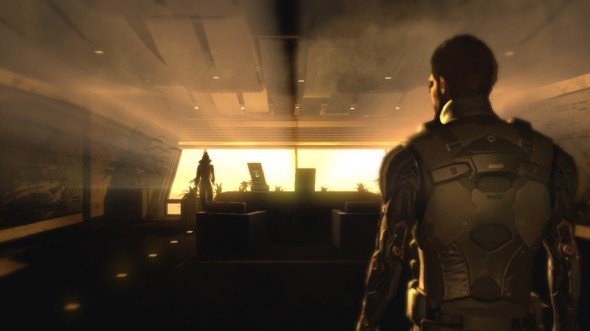
At the end of the opening half hour, you arrive back at Sarif Industries six months later, and are free to explore wherever you like. I had my priorities straight: find my office and check my mail, then find a ladies' bathroom and see if anyone complains if you go into it.
Sure enough, you have lots of mail if you choose to stop by your office before heading out on your first mission, from company-wide memos to messages of support from colleagues, and even a mail from the receptionist about a minor security matter she'd like you to look into. That mail starts a whole side quest about a thief in the company, one you could easily miss. And sure enough, I do find a ladies. Nothing of interest inside, but later your friendly tech stereotype Pritchard adds, after briefing you, “Your body's changed, Jensen, but you haven't become a woman. Stay out of the ladies.”
In your first proper mission, anti-aug purists have raided a Sarif facility to steal the prototype of their new explodeeverything aug, the Typhoon. It says something about Sarif, both the company and the CEO it's named for, that your primary objective is the Typhoon prototype and not the scientists' lives. It's even possible to get them killed before you so much as start this mission – dawdle too long after Sarif warns you to get to the helipad and they'll be dead before you even arrive.
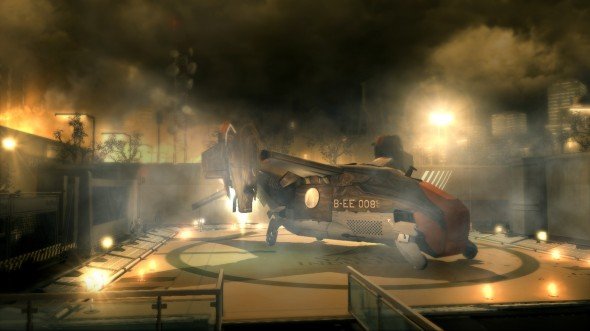
Before your chopper lands, Sarif tells you that “The rules of engagement are your call: do you want to go lethal or not?” It's the weapon selection conversation you had with your brother Paul at the start of the first game, but with one more choice – he then asks if you'd rather get close or engage at a distance.
I picked nonlethal and close up – basically Hard Mode – and got a Stun Gun: a short range Taser with just a few darts. If I'd gone with long range, I would have got a tranquiliser rifle – the equivalent of the first game's minicrossbow. Close range lethal is the Magnum revolver, and long range lethal is the assault rifle.
I was also given six Praxis points, level-up currency you'd never normally have this early in the game. It costs two points to get a new aug, and one point to upgrade an existing one with a new feature. I went for Strength, Cloak, and Legs with silent movement – the walk softly and carry a big box approach.
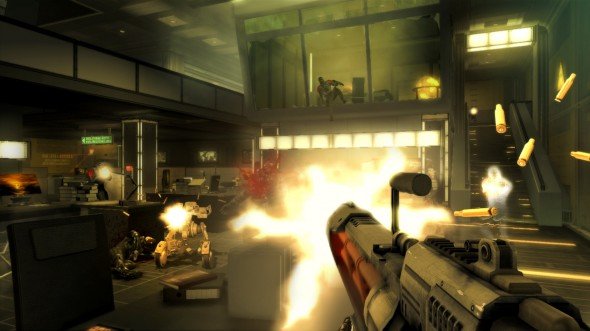
Despite not being designed for a player with augmentations, the mission immediately gives you lots of scope to use them. Two guards were talking around the first corner, so I used Strength to – yes! – stack a crate near a wall and peer over the top to scope them out. If I'd gone for the jumping upgrade for my Legs augmentation, I could have just hopped it. And if I'd used Brain to not be an idiot, I probably wouldn't have fallen over the wall into plain view of them both and had to run away again.
I snuck through the next few areas – big, airy storerooms in the Shipping and Receiving wing of the building – without engaging or even being seen by any of the guards. But deeper into the facility, things got tricky enough that I had to start tasing bros. Having exactly no manual skill with the Xbox 360 controller, my preferred method was to hide in cover until they almost passed me, then blind-fire with the stun gun and pray it hit, to take them out without exposing myself.
Regular guns kill with one headshot, but without a mouse that's usually beyond my talents. Human Revolution is incredibly stringent with ammo, too – I rarely had more than four rounds in a given weapon – so mowing everyone down wasn't an option.
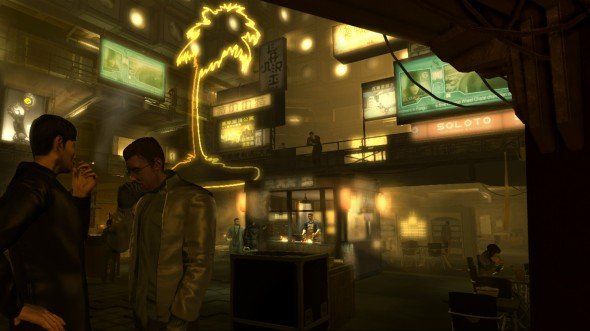
Whatever you specialise in, you can usually hit people with your robot arms. A melee takedown, whether you choose to make it lethal or just a knockout, consumes one cell of power. Other augs drain those cells more gradually, and if you've got less than one full cell, you can't use melee attacks at all. The good news is that your last cell always regenerates over time, so if you've run out of absolutely everything else – and I frequently did – you can still stalk a room full of enemies with a slow rhythm of sneaking and punching. Later levels have more energy bars – actual food – that restore one cell of power each, letting you store up a few cells for quick series of takedowns.
Once I got the hang of it, I tended to overuse the vicious third-person beat downs. I finally found the hostages, still alive in a room with a toxic gas canister ready to release. Its trigger was tied to the door I just came in through, so I had seconds to save them. I couldn't see a prompt to defuse the bomb, so I approached the hostages hoping to carry them out. All I got was the usual melee prompt: tap the button to knock them out, hold it to kill them. Well, I didn't want to kill them. Tap it is!
You're, er, not meant to punch the hostages. You certainly can, and you can even drag their limp bodies away. In fact, since I had Strength, I could have easily tossed this unconscious middle-aged lady out of the room with some force. The trouble was, the bomb trigger had also locked the door. By the time the gas started to leak out, all I could do was sneak out through the vent I should have come in through, while the surviving hostages screamed at me to stay away from them before choking to death.
I'm probably not going to win Secret Agent of the Year for that one.
The mission ends – some tough encounters later – in a confrontation with Zeke. He has a hostage, and you have a choice: talk him down, let him leave, or attack. Talking triggers the game's interesting conversational combat system: each tack you try gets a particular response from Zeke, and each of those has a right response, a wrong response, and one that will neither drive him over the edge nor calm him down. The exact lines Zeke throws at you are somewhat randomised, so you can't just memorise the correct responses to each, Monkey Island style. You have to think about what he's said and figure out the right counterargument for his frame of mind.
I just punched him. A friend, playing for Edge magazine, punched the hostage instead – an innovative solution he didn't quite intend, but which nevertheless saved her life. If you let Zeke go, you hear gunfire outside shortly afterward, and then he and the hostage both show up dead. You don't know for sure whether he shot her, or the SWAT team at the scene accidently killed them both.
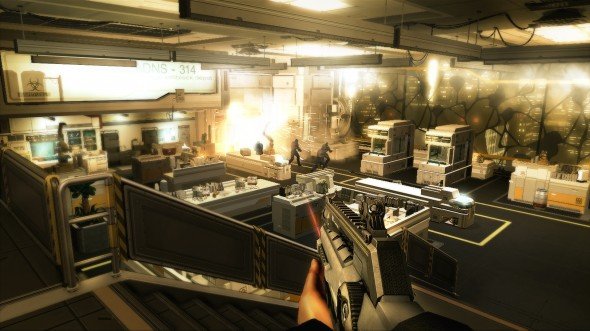
Human Revolution is a much tougher, harsher game than I imagined – even with augs you wouldn't normally have. It's visibly more futuristic than the first, the melee and cover are very different, and that first half hour really has nothing to do with Deus Ex. But none of these things stop the meat of the game from capturing the Deus Ex feel: thinking “OK, how do I want to play this?”, stumbling across interesting alternate routes, and panicking when it all goes wrong. Without that hard edge of difficulty, Human Revolution would miss the point. With it, it's a very exciting game indeed.
This preview was originally printed in issue 225 of PC Gamer UK. It includes information included in our previous web previews: one of the first three hours, and one of the very early stages of the game.

